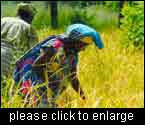InfoResources News No 3 / 04 (July
2004)
Special feature
> Appraisal of ten years of forest certification
Of current interest
Policy
> Does globalisation foster or endanger adapted
and diversified
agriculture?
> Agriculture Investment Sourcebook
> Workshop on decentralisation, federal systems
in forestry and
national forest programmes
> Mobility is critical for conservation
> New land laws in Africa: Are they equitable
and efficient?
Implementation
> National forest policy in Kyrgyzstan
> Livestock services and poverty reduction
> Information and Communication Technologies
(ICT) and rural
development in India
> Improving private sector participation (PSP) in
water supply
Research
> New Rice for Africa
Appraisal of ten years of forest certification
 The
aim of forest certification, as established by the Forest Stewardship
Council (FSC) in 1993, was to raise forest management standards
in the large tropical forest areas around the world in order to make
them more sustainable. Sustainable management implies forest planning
based on inventories; monitoring and evaluation; improved sylvicultural
techniques and biodiversity conservation. Tropical forests present an
enormous management challenge due to a complex set of issues. In terms
of the forests themselves, they often have more than 400 different tree
species and cover a large surface area. Governments in these areas often
have limited resources and capacity; the rights of the local communities
tend to be largely ignored; tenure rights are often poorly defined and
in some cases corruption is institutionalised. Of the 100 million hectares
of forest certified worldwide, only 3% are in tropical settings, and
of this certified tropical area only a very small percentage is in natural
forest settings. The
aim of forest certification, as established by the Forest Stewardship
Council (FSC) in 1993, was to raise forest management standards
in the large tropical forest areas around the world in order to make
them more sustainable. Sustainable management implies forest planning
based on inventories; monitoring and evaluation; improved sylvicultural
techniques and biodiversity conservation. Tropical forests present an
enormous management challenge due to a complex set of issues. In terms
of the forests themselves, they often have more than 400 different tree
species and cover a large surface area. Governments in these areas often
have limited resources and capacity; the rights of the local communities
tend to be largely ignored; tenure rights are often poorly defined and
in some cases corruption is institutionalised. Of the 100 million hectares
of forest certified worldwide, only 3% are in tropical settings, and
of this certified tropical area only a very small percentage is in natural
forest settings.
In its short existence, the expectations placed on forest certification
have
been too high. The study ”Certification in complex socio-political
settings”,
edited by Forest Trends, sets out the main challenges faced by certification
as it enters its second decade – in particular, finding ways to certify
forests in the tropics and in ”transition economies”. There, the situation
is exacerbated by the general lack of good governance and policy projects,
not to mention weak markets and continuing donor
dependence. However, the study also analyses experiences and capitalization
in several regions with a view to improving future certification
initiatives. Various norms, including the FSC, the Pan European
Forest Certification scheme (PEFC), as well as national and private-sector
initiatives, have produced promising results in Russia and Central and
South America.
The Russian case reflects various aspects of sustainable forest management
in practice. The certification project Priluzye Model Forest
(PMF), which covers 795,000 ha in the Komi Republic in northeast
Russia, was launched in 1996 by the WWF. In 2002, the NGO Silver Taiga
took over the reins with financial support from the Swiss Agency for
Development and Cooperation (SDC). One interesting part of this project
was the development of a mapping system for high conservation value
forests (HCVF) which comprise about 11% of the model forest area. The
inventory method was again adopted by regional forest authorities in
2001,
resulting in the mapping of 5.5 million ha of HSVF in the Komi Republic.
Since the exploitation of HCVF in theory requires FSC approval, the
various project partners were encouraged to set up a regional FSC Working
Group. Although this process has had a positive impact on the planning
of sustainable forest management, it has yet to become fully integrated
in current forest practices. The process in Russia suffers from a weak
institutional basis: instability of local forestry authorities, short-term
concessions and little knowledge of the value added gained through certification,
to name but a few.
Nevertheless, IKEA works closely with the WWF to develop the ”staircase”
model in Russia, an innovative certification approach. It is based on
an audit to pinpoint non-compliance of current forestry practices with
the sustainable forest management standard. The next step is to develop
a plan of action to remedy the situation, and then regularly check its
impact and any positive developments to which it may give rise. IKEA
uses this model to increase the quantity of certified wood and to ensure
that its home furnishing products come from sustainable forests.
Source: Certification in
complex socio-political settings: looking forward to the next decade.
Ed. Michael Richards. Forest Trends, 2004. 33 p.
www.forest-trends.org/resources/pdf/Complex%20Settings.pdf
For further reading:
> La certificación forestal y las comunidades: mirando
hacía la siguiente
década. Ed. Augusta Molnar. Forest Trends, 2003. 91 p.
www.gtz.de/forest_certification/download/d66s.pdf
> Etude de faisabilité sur la certification forestière
panafricaine. Ed.
Indufor Oy. INDUFOR, 2002. 112 p.
www.gtz.de/forest_certification/download/d63f.pdf

Of current interest: Policy
Does globalisation foster or endanger adapted and diversified
agriculture?
Liberalisation of world trade is continuing, although negotiations
are very
difficult as a result of the different positions taken on liberalisation
of agriculture. Two recent publications discuss consequences and pportunities
related to agricultural liberalisation from different perspectives.
Colin Hines believes that diversified local food systems, and hence
food security, are endangered. Global enterprises are increasingly influencing
agricultural production. Increases in production are being achieved
at the cost of employment conditions and environmental and social conditions.
Hines advocates ”localisation” of economic life, with a focus on local
self-determination and independence.
The authors of the discussion paper entitled ”Agriculture and Rural
Development”, on the other hand, believe that liberalisation offers
an opportunity for smallholders. By diversifying their product range
and moving away from industrial monocultures, they will be able to profit
from liberalised world trade. But diversified production systems, adapted
to natural conditions, must be able to respond with flexibility to the
needs and demands of the market. Access to current market information,
new technologies, and educating farmers are the most important conditions
for successful diversification. International donors must offer support
if poor population groups are also to benefit from these opportunities.
Sources:
> A Global Look to the Local: Replacing economic globalisation
with
democratic localisation. Colin Hines. IIED 2003. 79 p.
www.iied.org/docs/sarl/GlobaltoLocal_Hines.pdf
> Agricultural Diversification for the Poor: Guidelines
for Practitioners.
Shawki Barghouti et al. Agriculture and Rural Development Discussion
Paper 1. The World Bank. 2004. 48p.
http://lnweb18.worldbank.org/ESSD/ardext.nsf/11ByDocName/
AgriculturalDiversificationforthePoorGuidelinesforPractitioners/
$FILE/Diversification_Web.pdf
Agriculture Investment Sourcebook
One important pillar of the World Bank’s new rural strategy is the
promotion of agricultural growth to reduce poverty, while also giving
consideration to sustainable management of natural resources. A new
online sourcebook aims to help implement this goal. This reference work
gives project directors and other interested parties an overview of
positive (along with some negative) best practices and innovations relating
to agricultural investments to alleviate poverty.
The sourcebook is divided into 11 thematic modules covering political-institutional,
technological, ecological and economic issues. Each module contains
a general overview, summaries of best practices in specific areas of
investment, and examples of concrete innovative cases. The publication
offers quick insight into different thematic areas, although it contains
no
details about planning and implementation of investments.
While the first edition of this sourcebook is based primarily on best
practices garnered by the World Bank, incorporation of best practices
from other development organisations and countries is planned for later
editions.
Source: Agriculture Investment Sourcebook.
World Bank. 2004.
www-esd.worldbank.org/ais/
Workshop on decentralisation, federal systems in forestry
and national forest programmes
This country-led initiative organized by Switzerland (SAEFL, SDC, Intercooperation)
and Indonesia (Government and CIFOR) in support of the United Nations
Forum on Forests (UNFF) sought ways to improve the quality of ”on the
ground” forest-related activities. Questions regarding the balance between
centralization and decentralization, with a special focus on problems
that occur during transitional phases of the decentralization processes,
were discussed. As Jagmohan Maini, a UN professional, said, ”the many
thoughtful presentations and the outputs from the Working Groups at
the Workshop collectively constitute a very significant contribution
to the UNFF process, particularly in structuring the future deliberations
and debate on the topic in a more systematic manner, in terms of concepts
and the vocabulary”. A side event was organized at the 4th meeting of
the UNFF in Geneva on 4th May, with more than 60 participants, to inform
the intergovernmental community about the outcome of the Interlaken
workshop.
Concerning decisions of the UNFF in connection with the Interlaken Workshop,
delegates succeeded in introducing the term ”decentralization” into
the resolution on Social and Cultural Aspects of Forests. OP 8 accordingly
reads: ”Encourages countries as appropriate to explore options for decentralization
of decision making on sustainable forest management, including through
sharing experiences and lessons learned, as a possible means to effectively
address social and cultural aspects.”
An unedited draft report is available on www.intercooperation.ch/offers/
events/interlaken-2004/InterlakenUneditedDraftReport.pdf and
will be
improved to become an official UN document, which will be translated
into the 6 languages of the UN for the UNFF meeting in 2005 in New
York. As other possible outcomes, several countries, including Indonesia
and Switzerland, are now analyzing ways to promote realistic assessment
and implementation of decentralized forest management
processes.
Source: Interlaken Workshop on decentralization,
federal systems in forestry and national forest programmes, 27–30 April
2004, Interlaken, Switzerland www.iisd.ca/sd/forest/sdlak
Mobility is critical for conservation
Mobile peoples make valuable contributions to biodiversity conservation
through resource use that has been adapted to natural conditions over
hundreds of years, particularly in arid regions. Their migrations across
different habitats and sometimes across national boundaries create linkages
between different ecological zones, thereby increasing the dispersion
of seeds and insects. These traditions have created biological corridors
that are very important today for the preservation of entire landscapes.
The World Alliance of Mobile Indigenous Peoples, founded in 2003 at
the
World Parks Congress, is committed to work for the recognition and the
rights of mobile population groups, through better knowledge transfer
and
by exerting influence on legislation, policies and programmes. The new
alliance is also and above all committed to ensuring that protected
areas are not used to exclude mobile indigenous peoples from their traditional
grazing and migratory areas.
Source: World Alliance of Mobile Indigenous
Peoples. 2003.
www.iucn.org/themes/ceesp/WAMIP.htm
New land laws in Africa: Are they equitable and efficient?
In the last two decades traditional rules on land ownership and land
use have been incorporated into new land laws in sub-Saharan African
countries. Greater attention has been given to the rights of vulnerable
population groups such as women, pastoralists and migrants, and responsibility
for the granting of land rights and registration has been partly handed
over to local institutions. But is this enough for equitable and efficient
regulation of land ownership as an important condition for sustainable
land management? An IIED study made a comprehensive analysis of the
current status of land ownership and administration, drawing conclusions
from experience in areas such as land security, redistribution of land,
decentralised management, and improved conditions among vulnerable groups.
A lack of institutions, an insufficiently informed population, and the
need for increased linkage between land reforms and development were
three of the shortcomings identified.
Unfortunately, few concrete proposals have been elaborated to assist
the different actors concerned in making further improvements with respect
to
land issues. The diversity of social, legal and historical conditions
is so vast in African countries that such an aim would be difficult
to achieve in the scope of a summary study such as this one.
Source: Land Tenure and Administration
in Africa: Lessons of Experience and Emerging Issues. Lorenzo Cotula,
Camilla Toulmin, Ced Hesse. IIED, FAO 2004. 44p. ISBN: 1 84369 497 2

Of current interest: Implementation
National forest policy in Kyrgyzstan
A ”community of practice” assembled at a meeting organised by the FAO
in November 2003 to examine the instruments used to evaluate stakeholder
participation in national forest programmes. One paper presented at
this meeting offers a step-by-step guide to the experiences of Kyrgyzstan
in relation to participation in its national forest programme over the
past five years. It highlights elements that could prompt similar evaluation
processes for different situations. The principles, defined by the National
Concept for Forestry Development, concern biodiversity conservation
and combating poverty. The evaluation criteria applied in Kyrgyzstan
mainly focus on improving the image of the national forestry service
and promoting sustainable use of forestry resources among the local
population. The paper also examines the indicators (at the development
stage) and relevant verifiers to assess the participation
of forest rangers in management planning, the distribution of profits
from the sale of forestry products to benefit households, and to measure
both the number of stakeholders involved in community-based forest management
and the surface area of new plantations.
Sources:
> Enhancing stakeholder participation in national
forest programmes.
Proceedings of the second technical meeting of the community of
practice, Rome, 24–25 November 2003. 3 p.
www.fao.org/DOCREP/MEETING/007/AC922E/AC922E00.HTM
> Annex 5, National Forest Policy in Kyrgyzstan: 5 years on
the road
with participation. 16 p.
www.fao.org/DOCREP/MEETING/007/AC922E/AC922E07.htm
Livestock services and poverty reduction
 The
marked increase in demand for meat and dairy products in developing
countries could prove an opportunity for millions of poor livestock
keepers. However, livestock services provided by development programmes
so far are not sufficiently oriented towards small-scale livestock farming
and poverty reduction. A new study based on literature and case studies
has investigated into the question of what measures are needed to change
this. The
marked increase in demand for meat and dairy products in developing
countries could prove an opportunity for millions of poor livestock
keepers. However, livestock services provided by development programmes
so far are not sufficiently oriented towards small-scale livestock farming
and poverty reduction. A new study based on literature and case studies
has investigated into the question of what measures are needed to change
this.
The following two prerequisites are seen as pivotal for successful implementation:
On the one hand, it is necessary to identify those regions and production
systems where livestock development is most liable to efficiently contribute
to poverty reduction. On the other hand, poor livestock keepers must
be much better integrated into planning and implementation processes
of development programmes. Apart from these, the study suggests many
other measures to improve livestock services, such as an efficient distribution
of roles between the public and private sectors, a more specific integration
of women, consideration of the special concerns of communities suffering
from AIDS, promotion of producer organisations, use of better adapted
technologies, and
financial services for the poorest. Very little attention is given to
the consideration of environmental concerns.
Source: Livestock services and the poor.
A global initiative. Collecting,
coordinating and sharing experiences. IFAD, DANIDA, The World Bank.
Rome, March 2004. 152 p. www.ifad.org/lrkm/book/english.pdf
For further reading: The Role of Livestock
in Economic Development and Poverty Reduction. Martin Upton. Pro-Poor
Livestock Policy Initiative Working Paper No. 10, FAO, 11. February
2004. 66p.
www.fao.org/ag/againfo/projects/en/pplpi/docarc/wp10.pdf
Information and Communication Technologies (ICT) and
rural development in India
Three ICT projects in India strive to achieve one common goal: to provide
the rural population with useful information. Village centres equipped
with computers and internet access – so-called kiosks – function as
information hubs and can be consulted by farmers seeking information
on the weather, market prices, and agricultural know-how; project employees
provide advice. One of the projects is run by the government, the second
by a sugar cooperative with government support, and the third is run
by an agricultural supply company.
A study examined all three projects. Its findings indicate that the
kiosks are most frequently visited by young, rather well-educated men.
Surprisingly, in the state-run project poor population groups have participated
to a representative extent. Everywhere, kiosks were met with great interest
by the rural population,
although ICT has been used predominantly for communication and
less for searching for information. Due to their different nature, the
three projects were hardly comparable.
Even though the study shows that the potential of ICT is by no means
exhausted, these projects are more than just conventional extension
services with a particularly generous computer budget. Numerous initiatives
by the state, NGOs and the private sector to introduce ICT in rural
regions will certainly develop quickly. They will contribute to narrowing
the digital gap between rural and urban areas.
Source: Information and Communication
Technology in Agricultural
Development: A Comparative Analysis of Three Projects from India. Shaik.
N. Meera, Anita Jhamtani, D. U. M. Rao. In: AgREN Network Paper No.135,
odi, January 2004. 20p.
www.odi.org.uk/agren/papers/agrenpaper_135.pdf
Improving private sector participation (PSP) in water supply
 One
of the Millennium Development Goals is to halve the percentage of the
world’s population with no access to clean drinking water, sanitary
installations and waste water treatment plants by 2015. This goal can
only be achieved if government institutions, multilateral organisations,
the private sector, and civil society join forces. Better integrating
the private sector is one possibility to improve efficiency in the water
sector. However, there is often a lack of guidelines and instruments
to help plan and implement effective, efficient and equitable PSP projects. One
of the Millennium Development Goals is to halve the percentage of the
world’s population with no access to clean drinking water, sanitary
installations and waste water treatment plants by 2015. This goal can
only be achieved if government institutions, multilateral organisations,
the private sector, and civil society join forces. Better integrating
the private sector is one possibility to improve efficiency in the water
sector. However, there is often a lack of guidelines and instruments
to help plan and implement effective, efficient and equitable PSP projects.
Together, the Swiss Government, represented by the SDC and seco, and
Swiss Re have launched an initiative to develop policy principles describing
stakeholders’ basic values, key factors, functions, and responsibilities,
as well as implementation guidelines for specialists featuring information
on specific tools and examples of successful PSP projects.
Among others, the initiative mentions the following key factors as necessary
preconditions for successful private sector participation: poverty responsiveness,
resource conservation, transparency, socially and economically balanced
financing, and proactive risk management.
A toolbox with a set of checklists, tools, references and case studies
will provide support for operational implementation of PSP projects.
Source: Policy Principles
and Implementation Guidelines for Private Sector Participation in Sustainable
Water Supply and Sanitation Services. Swiss Agency for Development and
Cooperation SDC, SwissRe, State Secretariat for Economic Affairs seco.
April 2004.
www.pspwater.org/public/index.html

Of current interest: Research
New Rice for Africa
 Sierra
Leonean researcher Dr. Monty Jones has been decorated with the World
Food Prize 2004 for his development of a New Rice for Africa (NERICA).
By crossing high-yield Asian varieties with a locally well-adapted African Sierra
Leonean researcher Dr. Monty Jones has been decorated with the World
Food Prize 2004 for his development of a New Rice for Africa (NERICA).
By crossing high-yield Asian varieties with a locally well-adapted African
variety, he managed to breed a promising new kind of rice. The most
important advantages of NERICA are: higher yields, shorter vegetation
period, higher protein content and resistance against pests and draught.
Such a rice variety has a great potential in West and Central Africa.
The food situation in this area is critical. In addition, the demand
for rice increases by 6% every year due to urbanisation and changing
consumption habits. To meet these needs, rice is imported at high costs.
The 20 million local smallscale producers – a large portion of them
being women – do not have the money necessary to increase the yield
of conventional varieties by irrigation, fertilisation or pesticides.
NERICA can help improve this situation. In 1996 the first farmers evaluated
the new varieties. During recent years the cultivation area of NERICA
has grown considerably in the highlands of West and Central Africa.
The NERICA project intends to introduce the rice variety also in the
lowlands, where the climate is different, and in East Africa. The great
breakthrough has yet to come: The adoption of new products by farmers
takes time.
Sources:
> Chinese and African Scientists Named Co-Winners of the 2004
World Food Prize. Press Release. The World Food Prize Foundation. 3
p.
www.worldfoodprize.org/04laureates/prelease.htm
> NERICA on the move. A symbol of hope for rice farmers in Africa.
West Africa Rice Development Association (WARDA) – 2003. 5 p.
www.warda.org/NERICA%20flyer/technology.htm
> New Rice for Africa: NERICA – Rice for Life. West Africa Rice Development
Association (WARDA), 2001. 8 p.
www.warda.org/publications/NERICA8.pdf

|




